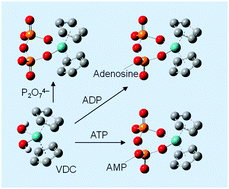Biorelevant reactions of the potential anti-tumor agent vanadocene dichloride†
Abstract
The interaction of the potential anti-tumor agent vanadocene dichloride ([Cp2VCl2] or VDC) with some relevant bioligands of the cytosol such as proteins (Hb), amino acids (glycine and histidine), NADH derivatives (NADH, NADPH, NAD+ and NADP+), reductants (GSH and ascorbic acid), phosphates (HPO42−, P2O74−, cAMP, AMP, ADP and ATP) and carboxylate derivatives (lactate) and its uptake by red blood cells were studied. The results indicated that [Cp2VCl2] transforms at physiological pH into [Cp2V(OH)2] and that only HPO42−, P2O74−, lactate, ATP and ADP form mixed species with the [Cp2V]2+ moiety replacing the two hydroxide ions. EPR and electronic absorption spectroscopy, agarose gel electrophoresis and spin trapping measurements allow excluding any direct interaction and/or intercalation with DNA and the formation of reactive oxygen species (ROS) in Fenton-like reactions. Uptake experiments by erythrocytes suggested that VDC crosses the membrane and enters inside the cells, whereas ‘bare’ VIV transforms into VIVO species with loss of the two cyclopentadienyl rings. This transformation in the cellular environment could be related to the mechanism of action of VDC.


 Please wait while we load your content...
Please wait while we load your content...